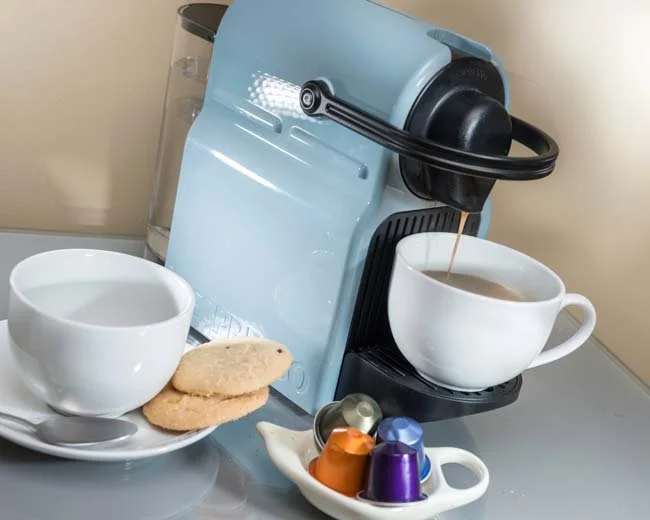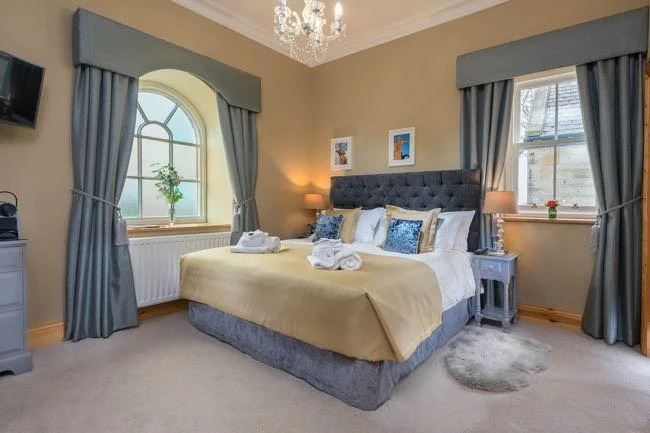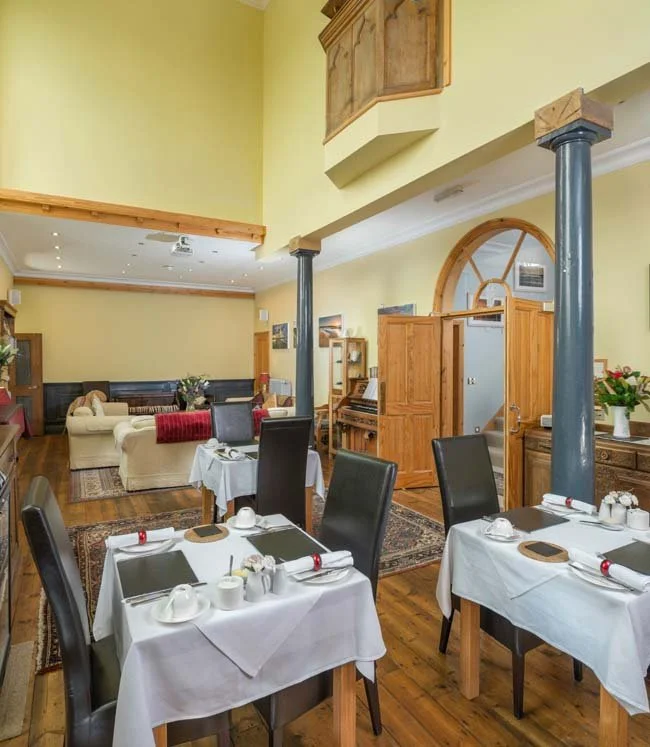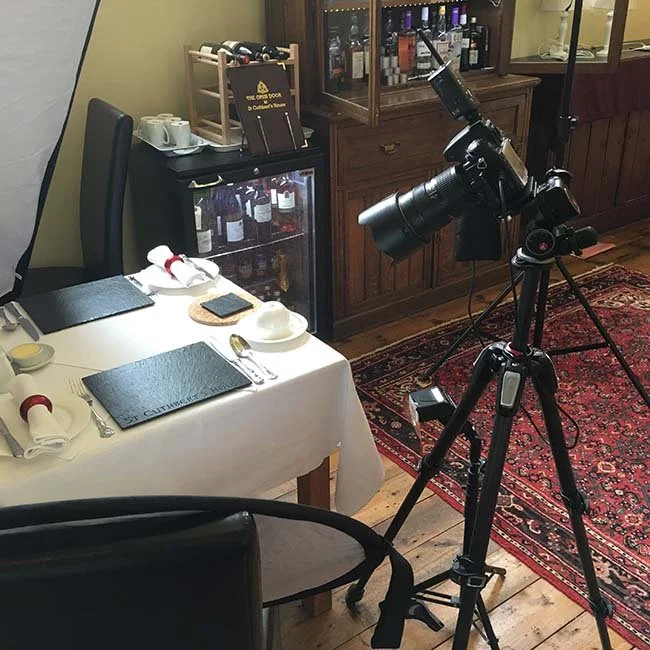Time for refreshments
A few years ago, I was lucky enough to be contacted by Time Out Guides, who commissioned me to shoot a whole bunch of stuff throughout North Northumberland for one of their travel publications detailing some of the top hotels, restaurants and beauty spots in the region I call home. One of these places was a relatively new B&B in the village of North Sunderland on the outskirts of Seahouses. St. Cuthberts House is an old church, derelict for a long time, and bought up by Jeff and Jill Sutheran, who moved up from Teesside after Jeff retired from the Fire Service. I took some very basic hand-held interiors, an exterior shot, and an environmental portrait of the 2 of them outside. Some time later, Jeff gave me a call and asked me to spend a day there shooting the rooms and some breakfast items for their website. I spent two days there in the end – taking great pains to cover everything in detail using a multitude of lighting and equipment. Those shots are used worldwide on various accommodation listing sites, and I was delighted when they won a national tourism award for B&B of the year – beating hundreds of other superb UK establishments. Some of the images went into my early portfolio, even though at the time, I was a fashion product and PR specialist, strictly speaking.
I was therefore delighted to be called again by Jeff a few weeks ago with a view to visiting again to shoot what I call a “refresh”. The rooms had been given some more oomph with new furnishings, accessories, and decor. This time, I had the kit, the experience, and the techniques to supply a range of beautiful images which would be perfect for their continued promotional efforts for the next five years. I also had the ultimate luxury that interior shooters can enjoy – a venue that has been closed to the public especially for me! Luckily, Jeff and Jill had the foresight to shut for one day in order to get everything done and dusted. My brief was simple – two classic shots of each room, selected cameo feature images of facilities and styling highlights, new images of the dining/lounge room, an external, and refreshed photos of the breakfast menu. I had a cuppa, unpacked my gear, and waited for the guests to check out so I could get cracking.
Rooms first then. Each room was shot in much the same way I would approach real-estate images, but with a great deal more detail given as to how the elements within the space look. A whole day is a long time, and gives you enough opportunity to put effort into viewpoint, lighting, and composition. We moved wardrobes to get into corners, and Jill, the stylist of the team, was fastidious in her attention to detail – straightening curtains, adjusting table lamps, and ironing out creases in bed sheets. As I shot a room, another was being prepared by the housekeepers in order to maintain a workflow right through the day. The lighting was controlled carefully in order to match the mood of the room. Some rooms were bright and airy, while others retained a degree of warmth witch suited a low-key lighting approach. As well as the basic exposure, and the series of flash highlights, I also shot a number of ambient exposures using only the window light. These frames were blended carefully with the others using a technique known as luminosity masking – it allows you to remove some of the artificial light look, and add subtle shadow areas here and there. Ambient exposures tend to be backlit, which is always the best quality type of light, as it shows off surface textures. More of that later. I used my Nikon D800 for it’s beautiful 36 megapixel files full of dynamic range, and my 14-24mm Nikkor, near the wide end, at around 18mm.
The cameo shots are always fun to do – it allows you to stretch out a bit, and make a little work of art. The idea was to feature some of the facilities in the rooms – TV’s, soft furnishings, special wallpapers etc. Once again, the technique was the same – a basic exposure, and carefully controlled flashes on various surfaces. I shot one cameo in each room.
The rooms took me the best part of six hours to complete without resting. I was tired & sweating, but satisfied with what had been done so far. The toughest room in the house was next. The dining room is a huge space with a tall central section stretching right up to the roof, and then there are sections at either end with low ceilings and zero natural light. To top it off, there are two huge stained glass windows piling coloured light onto the floor. Oh….and the walls are yellow. It’s a big light-challenged sandwich, and I had to take a bite. First things first – composition and viewpoint. I chose the same position as my last visit, but the tables didn’t look right. The place was set up to accommodate diners, but it didn’t look aesthetically nice for photography. i spent 20 minutes moving the tables until it looked good in-camera. Lighting the area needed some thought. I used the strong window light to illuminate the upper part of the tall section, then set up a Bowens 500J flash with a large white brolly, and directed it into the low-ceiling space from behind and above the camera. Another flash was hidden behind the furthest pillar on 1/16th power to lift the very back of the room out of darkness. several pops of light were then added to furniture, dining tables etc. I used my 24mm PC-E architectural lens shift feature to shoot the frame in two sections. These were stitched together using Photoshop CC later on.
My last task of the day was to photograph the various breakfasts, and the Krups coffee machines which were a feature in all the rooms. I’m not a food photographer, but have done my fair share of paid jobs, and have a tried & tested workflow which is simple and effective. Food always looks best when shot with natural light positioned behind the dishes, but when this isn’t possible, a big soft box positioned inches away does the trick. The backlighting brings out texture in the food, and any dark shadows can be eliminated with a simple white bounce reflector. One of the advantages of shooting food is scoffing the bugger afterwards, although I only indulged in a sausage on tis occasion. The coffee machine image is a composite of about 8 frames – with light being applied to various parts of the scene, and background.
I wrapped up the job at about 6pm after an end-of-day coffee. Jeff and the family are ardent Boro supporters, and we watched a live stream of the Smoggies securing their place in the Premiership before I headed home. I took Sunday off, and got to work with post-prod on Monday. Creating the final composites was a significant job. Jeff contacted me to ask for some edits to be done, and some of them were pretty heavy duty retouching tasks. I think he felt a bit guilty about the extent of some of them, but I always regard these things as part of the collaboration between me and the client, and it’s important that I get the job finished to the best of my ability.
I love Jeff and Jill – they’ve made a fantastic business out of an old derelict building, and they extend their warm welcome to everyone who crosses the threshold. Hopefully I managed to give them a set of images that will help take their success a bit further. Be sure to bear their pad in mind if you’re visiting Northumberland.












